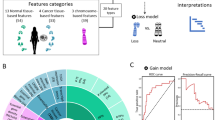Abstract
We consider a stochastic mechanism of the loss of resistance of cancer cells to cytotoxic agents, in terms of unstable gene amplification. Two models being different versions of a time-continuous branching random walk are presented. Both models assume strong dependence in replication and segregation of the extrachromosomal elements. The mathematical part of the paper includes the expression for the expected number of cells with a given number of gene copies in terms of modified Bessel functions. This adds to the collection of rare explicit solutions to branching process models. Original asymptotic expansions are also demonstrated. Fitting the model to experimental data yields estimates of the probabilities of gene amplification and deamplification. The thesis of the paper is that purely stochastic mechanisms may explain the dynamics of reversible drug resistance of cancer cells. Various stochastic approaches and their limitations are discussed.
Similar content being viewed by others
Literature
Abramowitz, M. and I. A. Stegun. 1964.Handbook of Mathematical Functions. Washington: National Bureau of Standards.
Alitalo, K. and M. Schwab. 1986. Oncogene amplification in tumor cells.Adv. Cancer Res. 47, 235–281.
Athreya, K. B. and P. E. Ney. 1972.Branching Processes. New York: Springer.
Axelrod, D. E., K. A. Baggerly and M. Kimmel. 1992. Gene amplification by unequal sister chromatid exchange: Probabilistic modeling and analysis of drug resistance data.J. theoret. Biol. (to appear).
Brown, P. C., S. M. Beverly and R. T. Schimke. 1981. Relationship of amplified dihydrofolate reductase genes to double minute chromosomes in unstably resistant mouse fibroblasts cell lines.Mol. Cell. Biol.,1, 1077–1083.
de Bruijn, N. G. 1958.Asymptotic Methods in Analysis. Amsterdam: North-Holland.
Cooper, N. S., M. E. Brown and C. A. Caulcot. 1987. A mathematical method for analysing plasmid stability in micro-organisms.J. Gen. Microbiol. 133, 1871–1880.
Doetsch, G. 1964.Introduction to the Theory and Application of the Laplace Transform. Berlin: Springer.
Harnevo, L. E. and Z. Agur. 1991. The dynamics of gene amplification described as a multitype compartmental model and as a branching process.Math. Biosci. 103, 115–138.
Harnevo, L. E. and Z. Agur. 1992. Drug resistance as a dynamic process in a model for multistep gene amplification under various levels of selection stringency.Cancer Chemotherapy and Pharmacology 30, 469–476.
Hyrien, O., M. Debatisse, G. Buttin and B. R. de Saint Vincent. 1988. The multicopy appearance of a large inverted duplication and the sequence at the inversion joint suggest a new model for gene amplification.EMBO Jl 7, 407–417.
Jones, R. B., C. K. Lumpkin and J. R. Smith. 1980. A stochastic model for cellular senescence. Part I. Theoretical considerations.J. theoret. Biol. 86, 581–592.
Kaufman, R. J., P. C. Brown and R. T. Schimke. 1981. Loss and stabilization of amplified dihydrofolate reductase genes in mouse sarcoma S-180 cell lines.Mol. Cell. Biol. 1, 1084–1093.
Kimmel, M. and D. E. Axelrod. 1990. Mathematical models of gene amplification with applications to cellular drug resistance and tumorigenicity.Genetics 125, 633–644.
Kimmel, M., D. E. Axelrod and G. M. Wahl. 1992. A branching process model of gene amplification following chromosome breakage.Mutation Res. 276, 225–246.
Lenski, R. E. and J. E. Bouma. 1987. Effects of segregation and selection on instability of plasmid pACYC184 inEscherichia coli.Brit. J. Bacteriol. 169, 5314–5316.
Novick, R. P. and F. C. Hoppensteadt. 1978. On plasmid incompatibility.Plasmid 1, 421–434.
Pakes, A. G. 1973. Conditional limit theorems for a left-continuous random walk.J. Appl. Probability 10, 39–53.
Perelson, A. S. and G. I. Bell. 1977. Mathematical models for the evolution of multigene families by unequal crossing over.Nature 265, 304–310.
Peterson, J. A. 1984. Analysis of variability in albumin content of sister hepatoma cells and a model for geometric phenotypic variability (Quantitative Shift Model).Somatic, Cell mol. Genetics 10, 39–53.
Seneta, E. and S. Tavare. 1983. Some stochastic models for plasmid copy number.Theoret. Pop. Biol. 23, 241–256.
Schimke, R. T. 1984. Gene amplification in cultured animal cells.Cell 37, 706–713.
Schimke, R. T. 1988. Gene amplification in cultured cells.J. Biol. Chem.,263, 5989–5992.
Schimke, R. T., S. W. Sherwood, A. B. Hill and R. N. Johnston. 1986. Overreplication and recombination of DNA in higher eukaryotes: Potential consequences and biological implications.Proc. Natl. Acad. Sci. U.S.A. 83, 2157–2161.
Smith, G. P. 1976. Evolution of repeated DNA sequences by unequal crossover,Science 191, 528–535.
Smith, K. A., P. A. Gorman, M. B. Stark, R. P. Groves and G. R. Stark 1990. Distinctive chromosomal structures are formed very early in the amplification of CAD genes in Syrian hamster cells.Cell 63, 1219–1227.
Stark, G. R. 1986. DNA amplification in drug resistant cells and in tumours.Cancer Surveys 5, 1–22.
Stark, G. R., M. Debatisse, E. Glulotto and G. M. Wahl. 1989. Recent progress in understanding mechanisms of mammalian DNA amplification.Cell 57, 901–908.
Stark, G. R. and G. M. Wahl. 1984. Gene amplification.Ann. Rev. Biochem. 53, 447–491.
Wahl, G. 1989. The importance of circular DNA in mammalian gene amplification.Cancer Res. 49, 1330–1340.
Widle, B., B. W. Draper, Y. Yin, S. O'Gorman and G. M. Wahl. 1991. A central role for chromosome breakage in gene amplification, deletion, formation, and amplicon integration.Genes and Development,5, 160–174.
Author information
Authors and Affiliations
Rights and permissions
About this article
Cite this article
Kimmel, M., Stivers, D.N. Time-continuous branching walk models of unstable gene amplification. Bltn Mathcal Biology 56, 337–357 (1994). https://doi.org/10.1007/BF02460646
Received:
Revised:
Issue Date:
DOI: https://doi.org/10.1007/BF02460646




